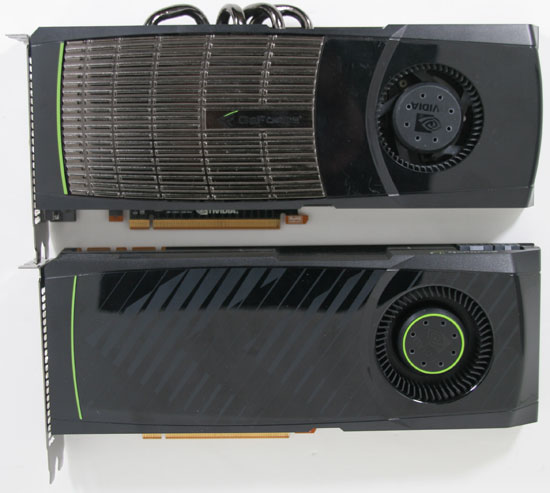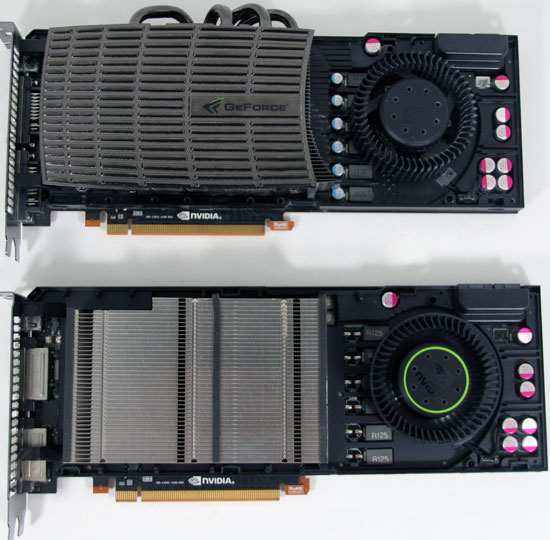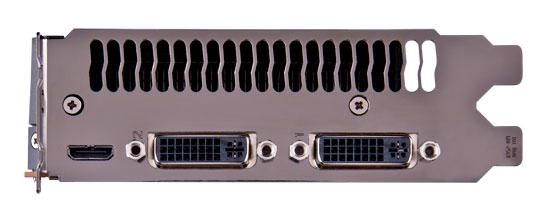NVIDIA's GeForce GTX 580: Fermi Refined
by Ryan Smith on November 9, 2010 9:00 AM ESTMeet the GTX 580
Since we’ve already discussed the cooling, let’s dive right in to the rest of the GTX 580, shall we?
Launching today will be a single GTX 580 design, the reference design. Talking to our contacts, semi-custom designs (designs using the reference PCB with a different cooler) are due in the next few weeks assuming everything goes to plan and of course there’s ample supply. And while we’re on that note, NVIDIA let us know that with their focus on cooling on the GTX 580 they aren’t going to be letting custom GTX 580 designs go out without a more thorough inspection. The acoustic performance of the reference GTX 580 is going to be the bare minimum to get a design approved – if it can’t beat the reference design, NVIDIA won’t allow it. We consider this a matter of brand protection for the company, as a bad/loud GeForce is still a GeForce all the same.

Top: GTX 480. Bottom: GTX580
With the reference design the resulting card is very close to being a GTX 285/480 hybrid. In terms of overall design it ends up looking very similar to the GTX 285. At 10.5” long it’s the same length as the GTX 480 or a smidge longer than the GTX 285, and should fit in to any cases those cards could work in. Power connectivity is the same as the GTX 480, with 6pin and 8pin PCIe sockets being located at the top of the card, providing easy access to the sockets. At 244W TDP the card draws too much for 6+6, but you can count on an eventual GTX 570 to fill that niche. Meanwhile NVIDIA has kept the 480’s detachable shroud lid, meaning you can remove the cover of the shroud without disturbing the rest of the card; it’s worth noting that it’s secured with screws rather than laches this time however.

Heatsinks Exposed! Top: GTX 480. Bottom: GTX 580
On the front side of the PCB you’ll find the 12 GDDR5 chips composing the card’s 384bit memory bus. The thermal pads connecting the memory to the shroud have once again wiped out the chip markings, so we haven’t been able to determine what these chips are, although we’re confident they’re 5Gbps like in past cards. At the center of the card is the GF110 GPU encased in a metal heatspreader, a common sight for NVIDIA’s high-end GPUs. This is an A1 revision GPU, which in NVIDIA’s counting system means it’s the first tape-out. Elsewhere on the board you’ll find the 2 SLI connectors, providing support for tri-SLI on the 580. All told while the GPU has been refined, the PCB remains largely unchanged from the GTX 480 other than removing the ventilation holes – all of the ICs are in practically the same place, and even the VRM controller is the same.
Meanwhile looking at the IO bracket for the 580, we find the same configuration as we saw on the 480. Below a full-sized vent are 2 DVI ports and a mini-HDMI port. NVIDIA slightly revised their display controller for GF110/GTX580; the good news is that HDMI 1.4a is supported, the bad news is that full audio bitstreaming is not supported so it’s the same as it was on the GTX 480: 8 channel LPCM and lossy audio formats like DD+ and DTS. This actually caught us off-guard since we were expecting the full GF104 treatment here, but it just goes to show that this is a GF100-derrivative after all. Unfortunately this also extends to the number of displays supported – NVIDIA still only supports 2 displays on one card, so you need to run in SLI if you intend to take advantage of 3DVision/NVIDIA surround across 3 monitors.

Finally, it’s with some sense of irony that we find ourselves yelling more at AMD than NVIDIA for naming shenanigans this time around, considering it was NVIDIA that brought us the 8800GT/9800GT and GeForce 200/300 product naming snafus. While NVIDIA has made some changes compared to the GTX 480, it’s a very short list; shorter than even AMD’s list for the 6800 series. At the same time, at least the GTX 580 is faster than the GTX 480 versus AMD’s 6800/5800 series. Quite frankly the GTX 580 should be the GTX 485 – the few architectural changes we’ve seen do make a difference, but then NVIDIA did a whole die shrink on the GTX 280 and only got a GTX 285 out of it. Both companies seem committed to coming out with a new family of video cards this year regardless of where the GPU powering them has actually changed. Ultimately the GTX 580 is the second flimsiest excuse for a new series number, next only to simply rebranding an existing GPU.











160 Comments
View All Comments
AnandThenMan - Wednesday, November 10, 2010 - link
"Relevent models only please, that have the same performance as the GTX580."So we can only compare cards that have the same performance. Exciting graphs that will make.
RobMel85 - Tuesday, November 9, 2010 - link
I browsed through the 10 pages of comments and I don't think I saw anyone comment on the fact that the primary reason Nvidia corrected their heat problem was by blatantly copying ATi/Sapphire...not only did they plagiarize the goodies under the hood, but they look identical to AMD cards now! Our wonderful reviewer made the point, but no one else seemed to play on it.I say weak-sauce for Nvidia, considering the cheapest 580 on NewEgg is $557.86 shipped; the price exceeds what 480 was initially and the modded/OC'd editions aren't even out yet. It can't support more than 2 monitors by itself and is lacking in the audio department. Yes, it's faster than it's predecessor. Yes, they fixed the power/heat/noise issues, but when you can get similar, if not better, performance for $200 less from AMD with a 6850 CF setup...it seems like a no brainer.
Sure ATi re-branded the new cards as the HD6000 series, but at least they aren't charging top $ for them. Yes, they are slower than the HD5000 series, but you can buy 2 6850s for less than the price of the 480, 580, 5970(even 5870 for some manufacturers) and see similar or better performance AND end up with the extra goodies the new cards support.
I am looking forward to the release of the 69XX cards to see how well they will hold up against the 580. Are they going to be a worthy successor to the 5900, or will they continue the trend of being a significant threat in CrossFire at a reasonable price? Only time will tell...
The real question is, what will happen when the 28nm HD7000 cards hit the market?
tomoyo - Tuesday, November 9, 2010 - link
Actually the newegg prices are because they have a 10% coupon right now. I bet they'll go back to closer to normal after the coupon expires...assuming there's any stock.Sihastru - Wednesday, November 10, 2010 - link
Vapour chamber cooling technology was NOT invented by ATI/Sapphire. They are NOT the first to use it. Convergence Tech, the owner of the patent, even sued ATI/Sapphire/HP because of the infringement (basically means stolen technology).LOL.
RobMel85 - Sunday, November 14, 2010 - link
Where within my post did I say it was invented by ATi/Sapphire...nowhere. The point that I was trying to make was that Nvidia copied the design that ATi/Sapphire had been using to trounce the Nvidia cards. The only reason they corrected their problems was by making their cards nearly identical to AMD/ATi...And to tomoyo, when I made that post there was no 10% coupon on newegg. They obviously added it because everyone else was selling them cheaper.
Belard - Wednesday, November 10, 2010 - link
This is still a "400" series part as it's really technically more advanced than the 480.Does it have additional features? No.
Is it faster, yes.
But check out the advancement feature list.
The 6800s, badly named and should have been 6700s, are slightly slower than the 5800s, but costs a lot less and actually does some things differently from the 5000 series. And sooner or later, there will be a whole family of 6000s.
But here we are, about 6months later and theres a whole new "product line"?
dvijaydev46 - Wednesday, November 10, 2010 - link
Is there any problem with Mediaespresso? My 5770 is faster with mediashow than mediaespresso. Can you check with mediashow to see if your findings are right?Oxford Guy - Wednesday, November 10, 2010 - link
The 480 beats the 580, except at 2560x1600. The difference is most dramatic at 1680x1050.http://techgage.com/reviews/nvidia/geforce_gtx_580...
http://techgage.com/reviews/nvidia/geforce_gtx_580...
http://techgage.com/reviews/nvidia/geforce_gtx_580...
Why is that?
Sihastru - Wednesday, November 10, 2010 - link
Proof that GF110 is not just a GF100 with all the shaders enabled.Oxford Guy - Wednesday, November 10, 2010 - link
This seems to me to be related to the slight shrinkage of the die. What was cut out? Is it responsible for the lower minimum frame rates in Unigine?